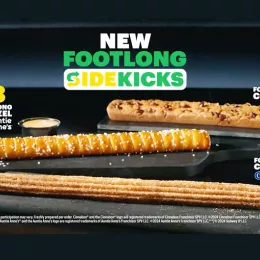How many calories are in McDonald’s & other milkshakes?

McDonald's.
Few people expect a fast-food milkshake to be low in calories. But large shakes—and similar drinks—are among the highest-calorie single items on many quick-service menus like McDonald's, Shake Shack, Starbucks, and Dunkin'.
McDonald's milkshakes

A McDonald’s Chocolate Shake ranges from 520 calories (for a small) to 650 calories (for a medium) and 800 calories (for a large). A large Vanilla Shake hits 780 and a large Strawberry Shake hits 850 calories. Compare that to a Big Mac (590), a Quarter Pounder with Cheese (520), or a Double Quarter Pounder with Cheese (740). The only item on McDonald’s menu with more calories than a large shake is an entire entrée with sides—the Big Breakfast with Hotcakes (1,340 calories).
Shake Shack milkshakes
"Regular" size Shake Shack shakes range from 680 calories (for Vanilla) to 1,160 (for a Loaded Chocolate Cookies & Cream). Most (like Chocolate, Black & White, Cookies & Cream, and Non-Dairy Chocolate) hover between 750 and 850 calories. (Shake Shack does offer “Mini” shakes of 10 flavors with “only” 340 to 510 calories—not exactly diet food but better than a Regular.) Still, only three single items on the Shake Shack menu top the highest-calorie shake. They’re the Triple Link Burger (1,190), Triple Lockhart Link Burger (1,300) and the Double Down Fries (1,910). That's close to the 2,000 calories that an average adult should eat in a day.
Starbucks Frappuccinos

Starbucks has no milkshakes, but some of its “blended beverages” come close. A Mocha Cookie Crumble Frappuccino packs 590 calories (for a 24 oz. “Venti”). Only one food—the 640-calorie Bacon, Sausage & Egg Wrap—has more calories. Several other Venti Frappuccinos with whipped cream and extras—like Chocolate Cookie Crumble Crème and Caramel Ribbon Crunch—clock in at around 570 calories. Note: These numbers are for Frappuccinos made with whole milk (the default), but most beverages can be “customized” to have fewer calories (e.g., with nonfat milk and no whipped cream) or even more calories (e.g., with cream).
Dunkin’ frozen drinks

You won’t find shakes at Dunkin’, but it’s got several flavors of Frozen Chocolate drinks that deliver roughly 900 calories in a “large.” And Dunkin’s “large” Frozen Coffees start at 550 calories and hit about 800 calories (with a Butter Pecan, Caramel, French Vanilla, or Mocha Swirl). Note: Those numbers are for Frozen Coffees made with whole milk (the default), but patrons can get fewer calories (with skim milk) or more calories (with cream). The highest-calorie food at Dunkin' is a Double Sausage Breakfast Sandwich (900), but that's unusual. Many sandwiches and donuts don’t top 600 calories.
Calories aren't the only problem with shakes
It's not just calories. Most shakes and similar drinks are loaded with unhealthy (saturated) fats and added sugars. For example, a Starbucks Venti Mocha Cookie Crumble Frappuccino has 17 grams of saturated fat (nearly a day’s max). And Dunkin’s large Frozen Coffees have roughly 25 to 35 teaspoons of added sugar (2 to 3 days’ worth). Sheesh.
What you can do
All of us deserve to know how food affects our health. That’s why CSPI led the fight to pass the law that requires restaurant chains to disclose calories on their menus and to disclose other nutrients (like saturated fat, sodium, and protein) upon request. We’re still pushing the Food and Drug Administration to require restaurants to disclose added sugars, just like food labels do. (Some chains do it voluntarily.)
Warning labels on restaurant menu items that are high in added sugars or salt would do even more to protect consumers by steering them away from the worst offenders. In fact, three nutrient warning bills now in New York State would, if passed into law, require the labeling of foods and beverages that have excessive levels of added sugars or sodium. Click here to learn more about New York’s statewide warning label campaigns or join CSPI in taking action.
Support CSPI today
As a nonprofit organization that takes no donations from industry or government, CSPI relies on the support of donors to continue our work in securing a safe, nutritious, and transparent food system. Every donation—no matter how small—helps CSPI continue improving food access, removing harmful additives, strengthening food safety, conducting and reviewing research, and reforming food labeling.
Please support CSPI today, and consider contributing monthly. Thank you.






